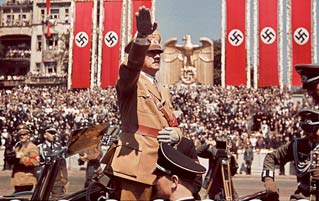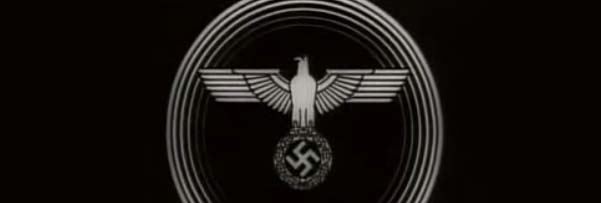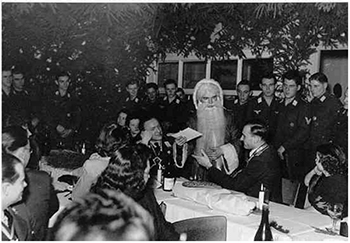8 Creepy Aspects Of Nazi Culture (You've Never Heard Of)

The Nazis were more than cartoon villains or a strained analogy thrown out in a first-year college essay. They were actual villains, whose sheer awfulness tainted almost everything they did. Even the fun things! Like television! And Christmas! And board games! They made board games so evil, you guys.
The Nazis Pioneered TV Entertainment With Menace-Laden Musical Interludes

Because of the difficulty in making television sets in the early days of the medium, German audiences in the '30s (in this case, high-society Nazi Party members and their staffs) who wanted to watch the ol' boob tube would have to gather in television parlors manned by the post office. German shows of this era were propaganda first, second, and third, with entertainment usually showing up around fourth or so, and often took the form of variety shows with young Aryans singing about how great it was to follow the edicts of the Third Reich.
If for some reason you don't want to watch Nazi propaganda during the workday, we'll summarize. There's some dancing and singing, and a jaunty number about how to tell the difference between the SA and SS. And then things get eerie.
It starts with this man:

Nothing too ominous about that.
This friendly chap proceeds to have an uncomfortably companionable chat with us about music, and the distress he feels at the unfortunate disharmonious elements who prefer to march to a different drum. He delightfully tells us how these "so-called foreign exchange musicians" are sent to "concert camps" to "sing for their supper."

It's pretty uncomfortable watching this, now that history has taught us what he was truly referring to. Television wouldn't reach this height of evilness again until the 1990s, when NBC aired that one episode of Frasier where Frasier and Niles repeatedly backed over the dog.
It's A Very Special Nazi Christmas!

The Nazis tried to fix Christmas once. If you didn't know Christmas needed fixing, then you must not think like a Nazi.
Their main problem with Christmas was that it was a celebration of Christ (it's in the name there) -- a man who, whatever his achievements, was also undeniably Jewish. That's a tough thing to celebrate when you're a Nazi, so their new version of the holiday, renamed "Julfest," became more of a celebration of traditional Germanic heritage. Yuletide carols with religious overtones were rewritten to match. For example, the new version of "Silent Night" had a lot more Hitler in it:
Silent night, Holy night / All is calm, all is bright. / Only the Chancellor stays on guard / Germany's future to watch and to ward / Guiding our nation aright.
Christma- er, Julfest trees were also discouraged, replaced by huge bonfires around which Hitler Youth members danced and conducted solstice rituals. Where trees did survive, they were decorated with a kitschy blend of traditional sun wheels, sig runes, and swastika-clad baubles.
Santa changed, too. Instead of being visited by Ol' Saint Nick, German children would now be inflicted with a terrifying new Germanic Santa derived from the Norse god Odin. He would also show up for the bigwigs, regularly appearing at Nazi functions to dole out presents to Goebbels, Himmler, and Hitler himself.

By the end of the war, with holiday cheer at somewhat lower levels than hoped, the Nazis changed gears again, rebranding the holidays as a time to remember the country's war dead. But they were doing more than honoring the dead; new lyrics written for one carol clearly said the dead would be rising from the grave and visiting them to receive their gratitude in person.
Merry freaking Christmas, children. Have some ghosts.
Hitler Sticker Albums!
Propaganda doesn't only have to be for adults, of course. Given their pliable minds and greedy, greedy hands, children are also a natural and easy target for indoctrination. After all, it was these perfect Aryan children who were needed to become the frontline soldiers of the Third Reich. Which is how we ended up with these:
That's a sticker album which parents could buy for their kids to fill with specially produced photographs (sold at their local store) of Hitler hanging out, like he was a member of One Direction or something.
Just a bit of motoring, hat-wearing, and genocide-planning.
It's like how today's kids collect trading cards, only with history's greatest monster smirking like a dickhead.
Juden Raus! -- The Holocaust Board Game!
Oh, and speaking of indoctrinating kids, let's have a quick look at the board game Juden Raus! (Jews, Get Out!), which you are unlikely to see on an episode of TableTop anytime soon.
In this game, players race tiny pointy-headed wooden figures meant to symbolize Jewish people toward a spot in the center of the board, whereupon they're deported to Palestine. The first player to evict six people wins, although clearly, no one's winning here.
It might be our modern sensibilities talking, but this doesn't look like fun at all.
This wasn't technically an official Nazi product, instead being made by a commercial manufacturer trying to edge in on that horrible, horrible market. It sounds like they shouldn't have bothered, either, because it seems the SS hated this game. When it was reviewed in their official magazine, they described it as a "a punishable idea" and "a piece of mischief" for making their job of hunting down Jews look like a silly hobby. You know, instead of the honorable profession it was.
Terrible Nazi Jazz
In Nazi Germany, jazz music was regarded as "degenerate" because of its sick beats, spontaneous trips up and down the Dorian scale, and lack of white dominance.
But that didn't stop Goebbels from forming a German jazz cover band to spread flashy, syncopated propaganda to help boost the war effort and demoralize Allied listeners. The band, Charlie and His Orchestra, specialized in playing jazz covers of American and British songs -- more specifically, bad covers of American and British songs. Their main problem was that in a simpler era of music piracy, the songs they copied had to be physically transcribed by hand at Nazi listening posts, leaving the original lyrics garbled. Their other main problem (they had a few main problems) was that these garbled songs were then rewritten to make statements about Germany winning the war.
Consider this horrible mangling of Cole Porter's "You're The Top":
You're the top / You're a German flyer / You're the top / You're machine gun fire / You're a U-boat chap / With a lot of pep / You're grand!
Or Bing Crosby's "Little Sir Echo":
Poor Mr. Churchill, how do you do? / Hello ... Hello ... / Your famous convoys are not coming through / Hello ... / German U boats are making you sore ... / You're nice little fellow, but by now you should know / That you never can win this war.
The music was quite popular in Germany, though it didn't have quite the same effect on Allied listeners. POWs who received the records reportedly gave elegant, concise reviews by smashing them after one listen.
Frauen Warte, The Bizarro Nazi Version Of Cosmopolitan
Nazis loved giving advice to anyone who didn't ask for it, and for women, a lot of that advice came from Frauen Warte ("Women's Viewpoint"), a biweekly propaganda magazine.
These magazines reinforced the Nazi belief that a woman's place was in the home, wearing a skirt and reading women's interest magazines (not a joke -- they printed a segment on why FW was important to the war effort). A Nazi woman's primary goal was to make more Nazis and raise them to be strong enough to "defend the fatherland with their lives."
FW also explained that a respectable Nazi(ette?) must never wear pants, high heels, or makeup, must never perm or color their hair, and must never threaten her man's manfulness by taking a job. FW also recommended enrolling in a six-week wife academy that would teach her how to keep him "comfortable."
Even Hitler wrote for Nazi Cosmo, at one point revealing what he'd like for his birthday: for women to "work hard." He really wanted a Battle Cat action figure, but was advised it would be gauche to ask all of Germany's women to buy it for him.
Prague's Jewish Museum Was Exactly The Horror Show You Can Imagine
If you're visiting a museum, it means that one of three things has happened: you're on a school field trip, you've found yourself the custodian of a mystical life-giving tablet, or you have a genuine interest in the world. But leave it to the Nazis to come up with a fourth option: You want to stare at exhibits about people you're trying to exterminate.
As a result of their actions during the Holocaust, the Nazis built up a sizable collection of Jewish artifacts. Much of these artifacts collected from their Czech territories eventually got sent to the Prague Jewish Museum for cataloging, curation, and eventual display in what would informally become known as the "Museum of the Extinct Race."
Jurassic Park, this was not. Alongside dioramas of everyday Jewish life, the Nazis installed exhibits depicting ritual animal slaughter. And not in a flattering way, either. But calling this propaganda sort of misses the point. This wasn't meant to justify or sell the Holocaust to anyone; that was already basically done with by this point. The fight was over. They were writing history.
As a brutally sad footnote, most of the museum's staff were Jewish themselves, and were trying to preserve their culture as best they could. At least a few of their possessions ended up in the museum's collection, as well. It's sort of like that old horror movie House Of Wax, only infinitely more terrifying.
The Nazi Summer Camps ... In America
With such a huge percentage of its population claiming German ancestry, it's hardly surprising that there were a number of Nazi sympathizers living in America in the 1930s. And like most people, they liked to camp.
And frolic and picnic and denigrate lesser races.
Although privately organized and not officially sanctioned by the Nazis, activities at these camps looked an awful lot like the kind of things going on in the Hitler Youth. Campers would engage in quasi-military drills, such as marching, raising banners, and rifle practice.

It should be noted that this was by no means an anti-American thing. Along with referring to themselves as the German American Bund ("alliance"), organizers of these camps proudly flew the American flag alongside or even above the Nazi flag. Not that this entirely placated the authorities. Many of the pictures in this article were reportedly taken by the NYPD, who were at least somewhat concerned by the presence of Nazi summer camps on Long Island.
If there's any good news, it's that once the war began, German-born Bund leader Fritz Julius Kuhn went to prison for tax evasion and embezzlement, and all the camps were shut down. And America never made a mistake like this again.
When they aren't rocking your world with bad puns and weird history (the best kind of history!), Marina and Adam can be found on Twitter.
2016 is almost over. Yes the endless, rotten shit hurricane of a year which took away Bowie, Prince and Florence Henderson and gave us Trump, Harambe and the Zika virus is finally drawing to a close. So, to give this bitch a proper viking funeral, Jack O'Brien and the crew, which includes Dan O'Brien, Alex Schmidt, and comedian Caitlin Gill, are going to send out 2016 with Cracked's year in review in review. They'll rectify where every other year-in-review goes wrong by giving some much needed airtime to the positive stories from the 2016 and shedding light on the year's most important stories that got overlooked. Get your tickets here.
Also check out 5 Reasons You're Picturing Nazis Wrong and 4 Insane Theories People Still Believe About the Nazis.
Subscribe to our YouTube channel, and check out Stuff That Must've Happened: The Last Guy To Wear A Hitler Mustache In America, and other videos you won't see on the site!
Follow us on Facebook, and let's not repeat history.




















